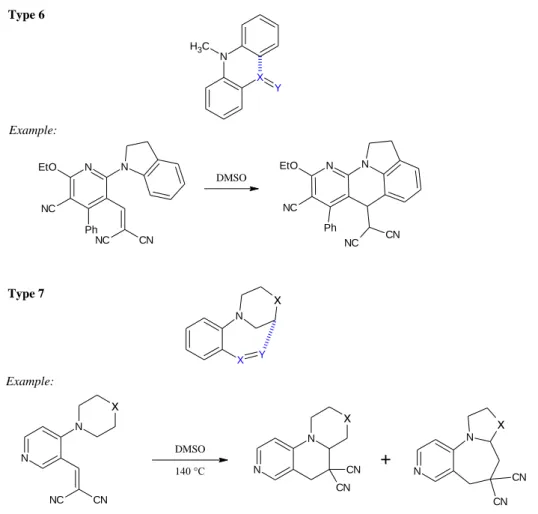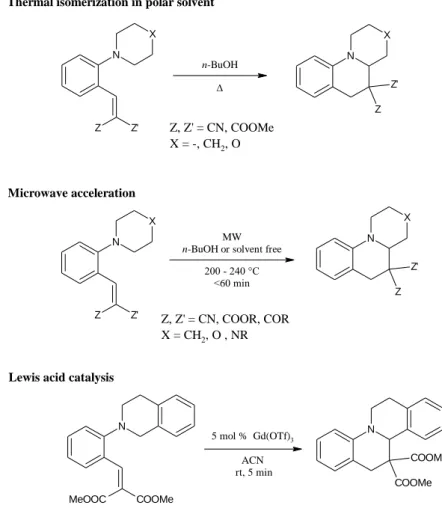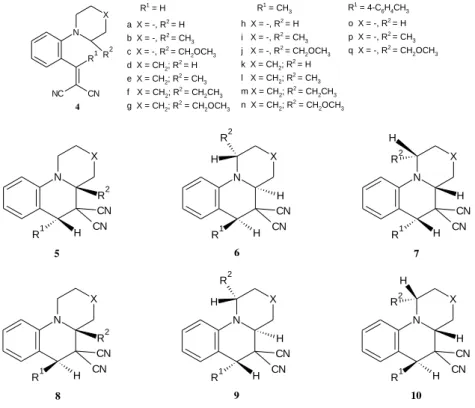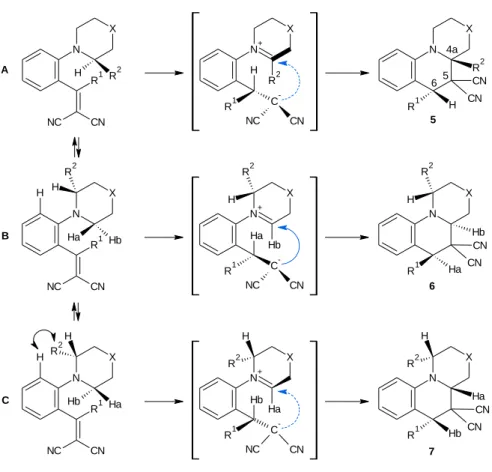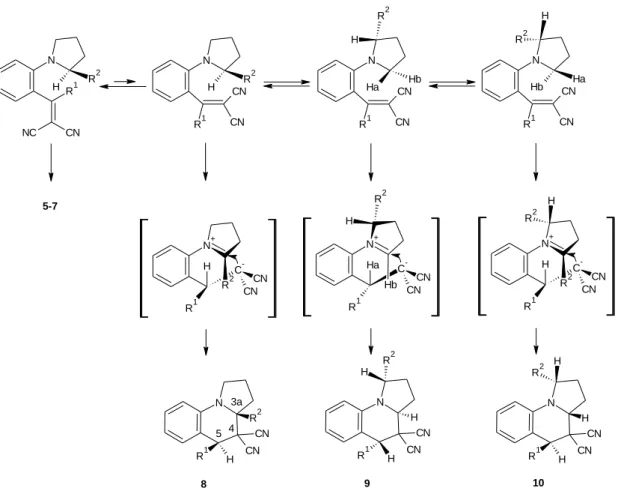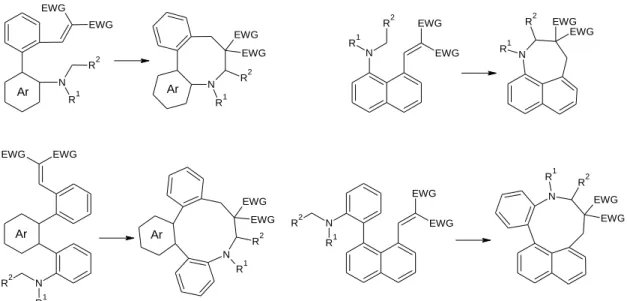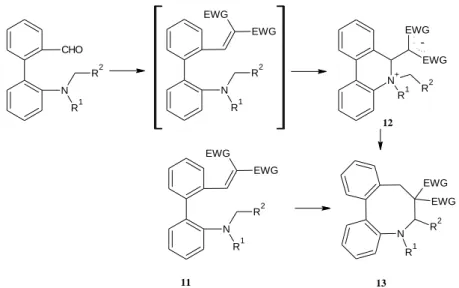Diastereoselective synthesis of novel
tetrahydroquinoline derivatives via tert-amino effect
Doctoral thesis
Dr. Ruth Deme
Semmelweis University
Doctoral School of Pharmaceutical Sciences
Supervisor: Professor Péter Mátyus, D.Sc.
Official reviewers: Dr. Hosztafi Sándor, C.Sc.
Dr. Kónya Krisztina, Ph.D.
Head of exam committee: Dr. Tekes Kornélia, D.Sc.
Members of exam committee: Dr. Kálai Tamás, D.Sc.
Dr. Őrfi László, Ph.D.
Budapest
2016
2
Table of Contents
List of abbreviations ... 5
1. Introduction and literature review ... 7
1.1. The tert-amino effect... 10
1.1.1. The types of the tert-amino effect ... 10
1.1.2. Application of the type 2 effect for the synthesis of tetrahydroquinolines ... 13
1.1.3. Stereo- and regiochemical aspects of type 2 reaction ... 15
1.1.3.1. Factors affecting the regioselectivity ... 16
1.1.3.2. Factors affecting the enantio- and diastereoselectivity ... 19
1.1.3.3. Proposed mechanism based on the stereochemical results ... 22
1.2. Application of the tert-amino effect for the synthesis of medium-sized rings ... 25
1.3. Synthesis of spirocyclic ring systems via the tert-amino effect ... 29
1.4. Microwave-assisted cyclizations via the tert-amino effect ... 33
1.5. Recent applications of the tert-amino effect – enantioselective tert-aminocyclization ... 36
1.6. Brief overview of semicarbazide-sensitive amine oxidase ... 40
2. Aims of the work ... 45
3. Materials and methods ... 48
3.1. General ... 48
3.2. Biology ... 50
3.3. Chemistry ... 51
3.3.1. General procedure for the synthesis of 2-(dialkylamino)acetophenone and benzophenone derivetives ... 51
3.3.2. General procedure for the synthesis of 2-vinyl-N,N-dialkylanilines from acetophenone derivatives ... 54
3.3.3. General procedure for the synthesis of 2-vinyl-N,N-dialkylanilines from benzophenone derivatives ... 54
3.3.4. General procedure for the synthesis of pyrido-fused ring system... 57
3.3.4.1. One-pot microwave reaction ... 57
3.3.4.2. Solvent free microwave reaction ... 58
3.3.4.3. Synthesis of spirocyclic ring systems ... 58
3.3.5. General procedure for the radical decyanation ... 71
3
3.3.6. General procedure for the reduction of the mononitrile derivatives ... 77
3.3.7. General procedure for the preparation of aminomethyl derivatives ... 82
3.3.8. Extension of type 2 reaction to bridged biaryls ... 86
3.3.8.1. Synthesis of N,N-dialkyl-2-[(methylamino)methyl]anilines ... 86
3.3.8.2. Synthesis of 2-{[2-(sec-amino)benzyl](methyl)amino} benzaldehydes ... 87
3.3.8.3. Synthesis of 2-(2-{[2-(sec-amino)benzyl](methyl)amino} benzylidene)malononitriles ... 89
3.3.8.4. Cyclization of 2-(2-{[2-(sec-amino)benzyl](methyl)amino} benzylidene)malononitriles ... 90
4. Results ... 92
4.1. Synthesis of pyrido-fused ring systems ... 92
4.2. Synthesis of mononitrile derivatives ... 96
4.3. Synthesis of aminomethyl derivatives ... 98
4.4. Synthesis of spirocyclic ring systems ... 99
4.5. Synthesis of bridged biaryls with methylamino-N-methyl group ... 104
5. Discussion ... 108
5.1. Pyrido-fused ring systems ... 108
6.1.1. Reaction mechanism ... 108
5.2. Mononitrile derivatives ... 110
5.3. Aminomethyl derivatives ... 111
5.4. Spirocyclic ring systems ... 112
5.5. Bridged biaryls with methylamino-N-methyl group ... 112
6. Conclusion ... 115
7. Summary ... 116
8. Összefoglaló ... 117
9. References ... 118
10. Publications ... 130
10.1. Publications of the author related to the present work ... 130
10.2. Publications of the author outside the scope of the present work ... 130
11. Acknowledgement ... 131
12. Appendix ... 132
4
12.1. 1H and 13C NMR spectra of selected compounds ... 132 12.2. HPLC chromatograms of selected compounds ... 138 12.3. Dose response curves of selected compounds ... 140
5 List of abbreviations
ACN Acetonitrile
Ac2O Acetic anhydride
AcOH Acetic acid
AIBN Azobisisobutyronitrile
2-BEA 2-Bromoethylamine
Boc tert-Butyloxycarbonyl
Boc2O Di-tert-butyl dicarbonate (-)-CSA (-)-Camphorsulfonic acid
CuAOs Copper-containing amine oxidases DBFox 4,6-Dibenzofurandiyl-2,2’-bisoxazoline
DBU 1,8-Diazabicyclo[5.4.0]undec-7-ene
DCE 1,2-Dichloroethane
DCM Dichloromethane
DEPTQ Distortionless Enhancement by Polarisation Transfer with retention of Quaternaries
DMB N,N-Dimethylbarbituric acid
DMF N,N-Dimethylformamide
DMSO Dimethylsulfoxide
DSC Differential Scanning Calorimetry
E Electrophile
EtOAc Ethyl acetate
EWG Electron Withdrawing Group
Gd(OTf)3 Gadolinium triflate
IC50 Concentration causing 50% inhibition of a given activity vs. killing treated cells
ID Indane-1,3-dione
LA Lewis acid
NBS N-Bromosuccinimide
6
MS Molecular sieves
MW Microwave
4-PBA 4-Phenylbutylamine
ORTEP Oak Ridge Thermal Ellipsoid Plot PCET Proton-coupled electron transfer
rfx reflux
TCE 1,1,2-Trichloroethane
TES Triethylsilyl
TMEDA N,N,N’,N’-Tetramethylethylenediamine
TMS Trimethylsilyl
TFA Trifluoroacetic acid
TPQ 2,4,5-Trihydroxyphenylalanine quinone
TPQAMQ aminoquinol
TPQox oxidised
TPQPSB product Schiff base
TPQSSB substrate Schiff base
Yb(tfc)3 Ytterbium tris[3-(trifluoromethylhydroxymethylene)-(+)- camphorate]
7 1. Introduction and literature review
The functionalization of nitrogen heterocycles plays an important role in drug research. This is clearly illustrated by the structures of several top emerging blockbusters as well as the best-selling drugs of 2013, all of which contain nitrogen heterocycles (Figure 1 and Figure 2)[1].
Figure 1: Top emerging blockbusters: drugs recently approved with $1 billion plus potential
8 Figure 2: Top-selling drugs on the market in 2013
Several methods exist for the synthesis of heterocycles functionalized next to nitrogen. One of the most efficient way, beside many others, is the direct functionalization of sp3 C-H bonds adjacent to nitrogen in heterocycles, including α- lithiation with alkyllithium/diamine complexes, α-amino radical formation, metal- catalyzed direct C-H activation, C-H oxidations and oxidative couplings and metal- catalyzed carbene insertions, respectively [2-4]. All of the previous methods require to use of external reagents and harsh conditions (Figure 3).
9
N (CH2)n C
H3 H
Boc
N (CH2)n C
H3 Li
Boc
N (CH2)n C
H3 E
Boc BuLi/TMEDA
- 78 °C
E+ - 78 °C
n=1, 2, 3 E=Me, TMS, CHO
A
N O
Br
C H2
(CH2)n
N O
(CH2)n CH3
N O C H2
(CH2)n H
. N
O
H
C H2
(CH2)n
.
Bu3Sn.
Bu3SnH/AIBN Toluene, rfx
1, 5 - hydrogen atom transfer
intramolecular cyclization B
electrophile
Figure 3: Functionalization of sp3 C-H bonds adjacent to nitrogen:
A α-lithiation/electrophile substitution, B radical-based C-H activation
The tert-amino effect is an internal redox process in the formation of nitrogen heterocycles with no other reagents required (Figure 4). The cyclization starts off with the cleavage of the migrating hydrogen (red H) from the α carbon atom of the secondary amino group, identical to sp3 C-H bond activation via 1,5-H transfer, affording a dipolar chiral intermediate and a subsequent stereocenter-generating C-C bond formation (R1 = CH3, 4-C6H4CH3; R2 = CH3, CH2CH3) [5]. Furthermore, the stereoselectivity of the tert-amino effect might provide information on the reaction mechanism.
10
N CN NC
H R2 R1
C-
N+ R1
CN NC
R2 H
*
dipolar chiral intermediate
N R1
CN CN R2 H
*
*
R1 = CH3, 4-C6H4CH3 R2 = CH3, CH2CH3
C-C bond formation [1,5]-hydride shift
Figure 4: tert-Amino effect: formation of six-membered ring from type 2 reaction
1.1. The tert-amino effect
The tert-amino effect has been known for more than forty years as a ring closure method of the ortho-substituted tert-anilines. The term tert-amino effect was first used by Meth-Cohn and Suschitzky [6]. However the first tert-amino effect transformation was reported by Pinnow in 1895 [7]. During the experiment, an unexpected cyclization was observed, giving rise to the formation of the 1,2-dimethylbenzimidazole (3), instead of the desired product acetyl derivative of o-aminodimethylaniline (2) (Figure 5).
N(CH3)2 NH2
N(CH3)2 NH
CH3
Ac2O O N
N CH3
CH3
1 2 3
Figure 5: Unexpected cyclization in the course of the Pinnow-reaction
1.1.1. The types of the tert-amino effect
Seven types of the tert-amino effect have been distinguished so far, based on the ring size and the mode of its formation. Meth-Cohn summarized five types of the tert- amino effect in 1996[8], and Quintela subsequently published two more types in 2003 [9]. The seven types of the tert-amino effect are displayed in Figure 6.
11
N
X Y Type 1
N
R1 R2 R3
N+
C- R1
R2 R3
N+
C- R1
R2 R3
[1, 6]
antara
disrot.
disrot.
N H R1
R2 R3
R3
N H R1 R2 Example: X=Y is C=C
Type 2
Example: X=Y is C=C
N
X Y
N R1
X
R2
NC CN H
N X
R1 H R2 CN
CN N+
X
R1 C- H
R2
CN NC [1, 5]
supra
12
Type 3
Example:
N
X Y
C H3
N CH3 CH3
ArNMeCHO POCl3 H3C
N CH3
H N+ C H3
C H3
N+ CH2 CH3
N C H3
R
N
N C H3
CH3 R
C H3 Type 4
Example:
N+ Y X
CH3 N
CH3 CH3
CON3
C6H6
N+ N- CH3
O CH3
CH3
Type 5
Example:
N+ Y X
N
O OH
[Ox]
[Ox] N+
O OH
Hg(II)/EDTA N
O O
13
Type 6
Example:
N C H3
X Y
N
NC CN N EtO
NC Ph
DMSO
N
NC CN EtO N
NC Ph
Type 7
Example:
N
x
X Y
N
N
x
NC CN
DMSO
140 °C N
N
x
CN CN
N
N
x
CN CN
+
Figure 6: The seven types of the tert-amino effect with examples
1.1.2. Application of the type 2 for the synthesis of tetrahydroquinolines
Tetrahydroquinolines have attracted attention due to their biological activities, some of them are presented in Figure 7 [10]. Beside pharmaceutical applications, tetrahydroquinoline derivatives have other widespread applications as well: pesticides [11], antioxidants [12], corrosion inhibitors, active components in various types of dyes [13], widely used in modern recording technologies [14], etc. According to the latest publications, remarkable biological effects of tetrahydroquinolines were described, such as anticancer activity and bromodomain inhibition[15, 16]. Furtheremore, treatment of arteriosclerotic diseases, hyperlipidemia, diabetes and insulin resistance were published as well[17, 18].
14
N H
N H N Br
O Br
O
N H OH
OH O
O OH
CH3 OH O
O CH3 O
Dynemycin A
(bacteria Micromonospora chersina) antitumor antibiotic
Natural products:
Pharmaceutical products:
N H HOH2C
O2N
NH
N O O OH NH
N
N H
HO2C Cl
OMe oxamniquine
schistosomicide
nicainoprol antiarrhythmic drug
viratmycin antibiotic Discohabdin C
(sponge of Latrunculia du Bocage) antitumor effect
Figure 7: Biologically active tetrahydroquinolines
One of the most plausible methods to synthesize a wide range of tetrahydroquinolines is the type 2 tert-amino effect. Several methods have been published from the 1980s, some of which are shown in Figure 8 (thermal isomerization [19], microwave acceleration[20, 21] and Lewis acid catalysis [22]).
15
N X
Z Z'
N X
Z Z' n-BuOH
Z, Z' = CN, COOMe X = -, CH2, O Thermal isomerization in polar solvent
N X
Z Z'
N X
Z Z'
Z, Z' = CN, COOR, COR X = CH2, O , NR Microwave acceleration
MW n-BuOH or solvent free
200 - 240 °C
<60 min
N
MeOOC COOMe
N
COOMe COOMe 5 mol % Gd(OTf)3
ACN rt, 5 min Lewis acid catalysis
Figure 8: Synthesis of tetrahydroquinolines via the tert-amino effect
1.1.3. Stereo- and regiochemical aspects of type 2 reactions
Reinhoudt and co-workers thoroughly investigated the influence of the steric and electronic effects of various substituents on the regio-, enantio- and diastereoselectivity of the ring closure reaction of 2-vinyl-N,N-dialkylanilines [23-25][5].
Because the diastereoselectivity aspects of tert-amino effect have been central to my investigations, the related literature is reviewed in-depth herein. Furthermore, in order to provide a more thorough summary of the mechanism of the tert-amino effect, regio- and enantioselectivity phenomena are analysed, as well.
16 1.1.3.1. Factors affecting the regioselectivity
The cyclization was carried out from compound 4 in refluxing n-BuOH to afford cyclized structures (5-10)[5], which were elucidated by 1H NOE spectroscopy (Figure 9). In case of the cyclization of compounds 4b, e, f (R1 = H and R2 = CH3 or CH2CH3), compounds 5b, e, f were formed exclusively. However, when R2 = CH2OCH3 both regioisomers (6c, g and 7c, g) were formed besides the formation of compounds 5c, g.
Similar results were obtained when R1 = CH3 (6j, n) or 4-C6H4CH3 (6p, q), but the ratio of the regioisomers formed was not 1:1.
N
R1 X
R2
NC CN
4
R1 = H
h X = -, R2 = H i X = -, R2 = CH3 j X = -, R2 = CH2OCH3 k X = CH2; R2 = H l X = CH2; R2 = CH3 m X = CH2; R2 = CH2CH3 n X = CH2; R2 = CH2OCH3
R1 = CH3
o X = -, R2 = H p X = -, R2 = CH3 q X = -, R2 = CH2OCH3 R1 = 4-C6H4CH3 a X = -, R2 = H
b X = -, R2 = CH3 c X = -, R2 = CH2OCH3 d X = CH2; R2 = H e X = CH2; R2 = CH3 f X = CH2; R2 = CH2CH3 g X = CH2; R2 = CH2OCH3
N X
R1 H R2 CN
CN
N X
R1 H H CN CN R2
H
N X
R1 H H CN CN H
R2
N X
R1 H R2 CN CN
N X
R1 H H CN
CN R2
H
N X
R1 H H CN CN H
R2
5 6 7
8 9 10
Figure 9: Vinyl compounds with various R1 and R2 substituents and their cyclized products
17 Table 1: Yields and reaction times of cyclizations
compound 4 reaction time
yield %
compound 5 compound 6 compound 7
a 2 h 82 - -
b 2 h 85 - -
c 1.5 h 46 19 17
d 2 h 78 - -
e 1.5 h 79 - -
f 1.5 h 80 - -
g 2.5 h 71 12.5 12.5
h 5 h 79 - -
i 5 h 79 - -
j 5 h 33 35 6
k 2 h 88 - -
l 2 h 88 - -
m 2.5 h 86 - -
n 3 h 56 28 8
o 3 days 86 - -
p 3 days 76 13 9
q 3 days 16 41 15
The formation of compound 5 took place predominantly or exclusively. This is due to a more effective stabilization of the tetrasubstituted iminium double bond in the dipolar intermediate over a trisubstituted double bond (Figure 10).
18
N R1
X
R2
NC CN H
N X
R1 H R2 CN CN N+
X
R1 C- H
R2
CN NC
N R1
X
Hb
NC CN Ha R2 H H
N X
R1 Ha Hb CN
CN R2
H N+
X
R1 C- Ha
Hb
CN NC R2 H
N R1
X
Ha
NC CN Hb H R2 H
N X
R1 Hb Ha CN
CN H
R2 N+
X
R1 C- HbHa
CN NC H R2
4a 6 5
5
6 A
B
C
7
Figure 10: Formation of compounds 5, 6, 7
Furthermore, the authors attributed the loss of regioselectivity to the sterical hindrance and inductive electron-withdrawing effect of the methoxymethyl group. If R2 is a bulky substituent, the heterocyclic ring rotates along the C-N bond, with Ha and Hb
acting as migrating hydrogens. The presence of oxygen destabilizes the iminium double bond in the dipolar intermediate, which serves the formation of the regioisomers, as well. Surprisingly, when R2 was a methyl group, the formation of the regioisomers was still observed, explained by the presence of the bulky R1 = 4-C6H4CH3(4p).
The ratio of the two regioisomers (compounds 6 and 7) depends on the size of the R1 substituent. Bulkier methyl group allows a more intensive rotation from the plane of the aromatic ring than R1 = H. Hence, the ring closure reaction (compound 6) is more preferred starting from conformer B, because of the steric hindrance between the methoxymethyl group and the aromatic hydrogen in conformer C (Figure 10). When R1
= 4-C6H4CH3, the heterocyclic ring rotates much further from the plane of the aromatic ring, thus the steric hindrance between the methoxymethyl group and the aromatic
19
hydrogen prevails less (Table 1). Because of the bulky 4-methylphenyl group, the molecule rotates along the phenyl and vinyl bonds affording diastereomers. The results of these reactions are discussed further in the 2.1.3.2. Chapter.
The authors concluded that the regioselectivity depends on the size of the R1 and R2 substituents, as well as on the electronic effect of R2.
1.1.3.2. Factors affecting the enantio- and diastereoselectivity
Regarding the diastereoselectivity, Reinhoudt and co-workers have published the following results starting from the racemic vinyl compound: i) if the migrating hydrogen and the hydrogen in the annulation are at the same face of the molecule only for R1 = CH3 and R2 = H, CH3, CH2CH3 or CH2OCH3 (compound 5). ii) When R1 = 4- C6H4CH3 the diastereomers are formed, as well (compound 8 in addition to compound 5, Figure 12).
The mechanism of the formation of the cis isomers (the relative configuration of the substituent at the bridgehead carbon atom and at the benzylic position) is displayed in Figure 10. When Ha or Hb is a migrating hydrogen, the ring closed products (compound 6 and 7) are enantiomers regarding the C-6 and C-4a positions, whilst compound 5 is represented as an enantiomer. Therefore it is concluded that the carbanion is added to the iminium double bond in the dipolar intermediates from the direction of the original location of the hydrogen atom.
The authors ascribe the formation of the diastereomers to the rotation of the vinyl moiety, which is influenced by the size of the substituent on the α-carbon atom of the vinyl moiety. Furthermore, the X-ray analysis of the vinyl compound [24] showed that the β-carbon atom of the vinyl moiety is pointed away from the heterocyclic ring (Figure 11). Important for the hydrogen shift to take place is the proximity of the migrating hydrogen of the α-carbon atom of sec amino group to the α- carbon atom of the vinyl moiety. When the migrating hydrogen atom (Ha or Hb) is attached to the carbon atom, it takes place from the conformer in which the β-carbon atom of the vinyl moiety is below the plane of the aromatic ring. It seems likely that the hydrogen migration takes place suprafacially.
20
Figure 11: ORTEP drawings of the crystal structure (the left) and the calculated structure (the right) of the compound 4a
However, the cyclization of the compound when R1 is a 4-methylphenyl group gives rise to compounds 8-10 in addition to compounds 5-7, which have the opposite configuration at C-5 (Figure 12). They explain this result by assuming that there is an interchange of the position of the vinyl group, because of the steric hindrance caused by the substituent R1 at the α-position of the amine ring. In this situation, hydrogen migration leads to the formation of an intermediate with a new asymmetric center that has the opposite configuration compared with the previous intermediates (Figure 10).
21
N R1
NC CN H R2
N H R2
R1 CN CN
N Ha Hb
R1 CN CN R2 H
N Hb Ha
R1 CN CN H R2
N C- H
CN R2 CN R1
+ N
C- Ha
CN CN R1
Hb R2 H
+ N
C- H
CN R2 CN R1
H R2
+
8 9 10
N CN CN
R2
R1 H
N CN CN
H
R1 H R2 H
N CN CN
H
R1 H H R2 3a
5 4 5-7
Figure 12: Formation of compounds 8-10
They concluded that the size of the substituent R1 determines the relative configuration of the substituent at the bridgehead carbon atom and at the benzylic position in the product because it directs the position of the vinyl moiety in the starting material.
The ratio of compounds 6p, q and 7p, q is determined by the sterical hindrance between the R2 substituent and aromatic hydrogen, as well. The difference among the previous results (when R1 = CH3) and these results is that the ratio of the regioisomers is lesser. They provided the explanation that the more bulky 4-methylphenyl group turns much more easily over the heterocyclic ring from the plane of the aromatic ring, thus this position is more favorable for the formation of compounds 7p, q, than the formation of compounds 7j, n (Table 1).
22
1.1.3.3. Proposed mechanism based on the stereochemical results
In order to gain more understanding of the mechanism of the tert-amino effect, Reinhoudt and co-workers carried out the ring closure reaction from the pure enantiomer [25], as well. During the reaction, the formation and the alteration of the new and the preexistent stereogenic centers can provide a more extensive explanation for the mechanism.
Ring closure of the S configuration of the vinyl compound (R1 = CH3 and R2 = CH2OCH3) resulted in the formation of compound 5j, 6j, 7j[23] (Figure 13). In addition to the required product (5j) the two regioisomers are formed, as well, because of the steric and electronic effect of the methoxymethyl group. The compound 5j was obtained as one enantiomer. 1H NMR spectroscopy of compound 5j in the presence of the chiral shift reagent (Yb(tfc)3), proved an enantiomeric excess of >98%.
N
R1 R2
NC CN H
N
R1 H
R2 CN CN
N
R1 Ha
Hb CN CN R2
H
N
R1 Hb
Ha CN CN H
R2 R1=CH3 R2=CH2OCH3
5j 6j 7j
4j
Figure 13: Chiral vinyl compound with S configuration and its ring closed products
In order to determine the absolute configuration of compound 5j, it was brominated with NBS. X-ray analysis showed that the methoxymethyl group at the bridgehead carbon atom and the methyl group at the new chiral center are in the trans position (Figure 14).
23
N
Br CN
CN H CH3
CH2OCH3
Figure 14: Crystal structure of the brominated compound
From these results the authors have given the following explanations: i) the 1,5- hydrogen shift proceeds enantioselectively; ii) the cyclization takes place with the retention of the configuration in the chiral center; iii) in the dipolar intermediate the carbanion is forced to add to the iminium double bound from below, namely from the α- position, because the β-position is shielded by the methoxymethyl group. In other words, the carbanion adds to the iminium double bond from the same face of the molecule where the migrating hydrogen originally was located. iv) The original chiral center was memorized in the form of a „unique chiral anticlockwise helical dipolar intermediate”.
The authors completed the above results with further investigations. They have assumed that the thermal isomerization proceeds via a concerted suprafacial 1,5- hydrogen shift followed by subsequent cyclization, which explains the discrete chirality in the product molecule and the primary isotope effect and solvent effect are supporting this [24]. In order to justify that the hydrogen atom migrates in the rate-determining step, some papers have been presented the investigation of the reaction with deuterated derivatives [24, 26, 27]. The group of Reinhoudt determined the deuterium kinetic isotope effect (3.0±0.3 at 91.5 °C in DMSO-d6) of the reaction, after the synthesis of the tetradeuterated vinyl compound (Figure 15). According to the 1H-NMR and mass spectra of the ring closed compound it was clear that during the cyclization of deuterated vinyl compound there was no deuterium lost. Furtheremore, they mentioned too that the hydrogen transfer could be an intramolecular variant of a Meerwein- Ponndorf-Verley reaction.
24
N CN NC
D D H
D D
N+ C- CN NC
D H D
D D
N
CN CN
D D H
D D
2 1 3 4
5 6
[1,5]-D
Figure 15: Deuterium migration in the rate-determining step
Further investigation of the stereochemical outcome of tert-amino effect was published in 1991 by Kelderman et al. [28]. They studied the Lewis-acid-catalyzed (ZnCl2) cycloreversion of cyclic dicyano and ethyl ester cyano derivatives (Figure 16).
From the results they concluded that 1) in the case of R1 = CH3 and R2 = H, CH3 after cycloreversion, interconversion of helical dipolar intermediate takes place with epimerization at C(3a) upon subsequent cyclization; 2) the stereochemistry at C(5) is retained after cycloreversion and cyclization, therefore the 1,5 hydrogen shift is irreversible; 3) the epimerization at C(3a) is influenced by the difference between the steric energy of the cis and trans diastereomers.
N
R1 H
R2 R3 CN
N
R1 H
R2 R3 CN N+
H R1
C- CN
R3 R2
N+
H R1
C- R3 R2 CN 3a
4 5
ZnCl2 ACN,
R1 = CH3 R2 = H, CH3 R3 = CN, CO2Et
Figure 16: Epimerization at C(3a) upon subsequent cyclization
In summary, regarding the mechanism of the type 2 tert-amino effect we can conclude that the 1,5-hydrogen migration takes place irreversible with suprafacially manner following by subsequent cyclization with configuration retention. The hydrogen
25
transfer is the rate-determining step, which enable to formation of chiral helical dipolar intermediate. The negative end of this intermediate is forced to add to the positive end of this molecule to affording ring closed product with a discrete stereochemistry.
1.2. Application of the tert-amino effect for the synthesis of medium-sized rings
In our extensive studies on the new extension of the tert-amino effect to biaryls and fused bicyclic systems, incorporating the interacting amino and vinyl groups in the two ortho or ortho and peri positions, respectively, have been developed to provide easy accesses to medium or macrocyclic rings [29-31] (Figure 17).
EWG EWG
N R1
R2
Ar N
EWG EWG R2 R1 Ar
EWG EWG
N R1 R2
Ar
N R1
R2 EWG
EWG Ar
N R1
R2
EWG EWG
R1 N
R2 EWG EWG
EWG EWG N
R1 R2
N R1 R2
EWG EWG
Figure 17: Synthesis of medium and macrocyclic ring systems via the tert-amino effect
Polonka-Bálint et al. investigated extensions of tert-amino effect to ortho,ortho’- fuctionalized biphenyl or phenylpyridazine derivatives [29]. They proposed to synthesize three types of vinyl derivatives (11), one with malononitrile and two other with indane-1,3-dione (ID) and N,N-dimethylbarbituric acid (DMB), respectively (Figure 18).
26
EWG EWG
N R1
R2 CHO
N R1
R2
EWG EWG
CN CN
O
O
N N O
O O CH3
CH3
11 R1=CH3, R2=H
R1+R2=(CH2)3 R1+R2=(CH2)4
Figure 18: Synthesis of 2-(2-vinylphenyl)-tert-aniline derivatives
Surprisingly, the Knoevenagel condensation of biphenyl carbaldehydes with ID and DMB in ethanol at room temperature furnished an unexpected phenantridinium product (12) (Figure 19), except in the case of R1+R2 = (CH2)4 with ID, which allowed the isolation of the expected vinyl compound (11). The formation of the phenantridinium compound can be explained by a ring closure between the positively polarized carbon of the vinyl group formed in the condensation reaction and the tert-amino nitrogen via a new type of tert-amino effect. The biphenylvinyl carbaldehyde condensed product with malononitrile as well as the phenantridinium derivatives could be isomerized (in DMSO at 110 °C or 160 °C under argon) to dibenzazocines (13) via another type of the tert- amino effect, namely antarafacial [1,7]-hydrogen shift.
EWG EWG
N R1
R2 CHO
N R1
R2
N R1
R2 EWG
EWG N+
EWG EWG
R1 R2 -
EWG EWG
N R1
R2
11
12
13
Figure 19: Formation of the phenantridinium compound (12) and the dibenzazocine (13)
27
Földi et al. studied the extensions of the tert-amino effect to 1-dialkylamino- and 1- (2-dialkylaminophenyl)-8-vinylnaphthalenes (compound 15 and 16), respectively, to form ortho- and peri-fused naphthazepine (17) and naphthazonine (18) ring systems [32] (Figure 20).
N CH3 C H3
CN CN
C N H3
EWG EWG N CH3
C H3
CHO
N+ C H3 C
H3 EWG
EWG -
CN CN N
N CN
CN 14
15
16
17
19
18
Figure 20: Formation of benzo[c,d]indolium (19), azepine (17) and azonine (18) ring systems
The Knoevenagel condensation of 8-dimethylaminonaphthalene-1-carbaldehyde (14) with malononitrile in ethanol at room temperature resulted the expected vinyl compound. However, treatment of carbaldehyde with ID and DMB led to zwitterionic benzo[c,d]indolium derivatives (19) via the tert-amino effect. From vinyl derivative (15), only the azepine (17) could be isolated in a good yield. The reactions were carried out in DMSO and solvent free condition at different temperatures with traditional and microwave heating. Transformation of zwitterionic compounds to azepines, could also be rationalized.
Dunkel et al. opened a new route to the formation of macrocycles via the tert- amino effect, to synthesize novel fused azecine ring systems by the microwave-assisted thermal isomerization of terphenyl (20) or biphenyl-pyridazine (21) compounds [31]
(Figure 21).
28
CN NC
N R1 R2
N R1
R2 CN
CN N N
CN NC
N R1 R2 R
O
N N N
R1 R2 CN
CN R
O
MW MW
R=CH3, Ph 20
R1=CH3, R2=H R1+R2=(CH2)3 R1+R2=(CH2)4
21
Figure 21: Extension of tert-amino effect to triphenyl compounds and their pyridazinone analogues
The formation of the azecine ring could be explained by two consecutive reactions:
i) the rate-limiting step involving [1,9]-hydrogen shift, resulting a dipolar intermediate, and ii) intramolecular C-C bond formation between the oppositely charged carbons.
Previously, Meth-Cohn and co-workers published the synthesis of dibenzo[b,f][1,5]diazocines via type 3 of the tert-amino effect [33-36]. The interaction of para-substituted tert-aniline (22) with N-formyl-N-substituted arylamides in POCl3
gives dibenzo[1,5]diazocines (24) (Figure 22).
C H3
N CH3 CH3
POCl3 H3C
N CH3
H N+ C H3
C H3
N+ CH2 CH3
N C H3
X
N
N C H3
CH3 X
C H3
N OHC
C H3
X
X=Cl, F, CHO 22
23
24
Figure 22: Synthesis of dibenzo[1,5]diazocines (24) via type 3 of the tert-amino effect
29
The reaction pathway could be rationalized by Vilsmeier formylation ortho to the dimethylamino group followed by [1,5]-hydrogen migration resulting new iminium ion (23). Subsequently, the C-C bond formation takes place between the iminium ion and the aromatic ring, affording diazocine derivatives.
The authors extended this methodology to the synthesis of benzo[b]naphtha[1,2- f][1,5]diazocines (25), as tetracyclic heterocycles and bis-dibenzo[b,f][1,5]diazocines (26), which could be novel macrocycles with flexible ring system[36, 37] (Figure 23).
N
X N
C H3
CH3
N
N N
N C H3
CH3
CH3
C H3
X X
25 X = F, Cl, Br, CH3, OCH3 26
Figure 23: Formation of macrocyclic ring systems using Vilsmeier reagent via tert-amino effect
1.3. Synthesis of spirocyclic ring system via the tert-amino effect
The group of Mátyus has revealed that the incorporation of the terminal vinylic carbon into a trioxopyrimidine ring of an ortho-vinyl-tert-aniline (27) accelerates the cyclization to the resulting spiro-substituted pyrido-fused diazines (28) (Figure 24) [26, 27, 38].
N N C H3
O CHO
X
N N
O C H3
X
A A B O
O
N N
N
B A A
X O
C H3
O
O
27a: A = NCH3, B = C=O 27b: A = O, B = C(CH3)2
i ii
28a: A = NCH3, B = C=O, X = CH2 28b: A = O, B = C(CH3)2, X = CH2O X = morpholino, pyrrolidino
Figure 24: Reagents and conditions: i) DMB or Meldrum’s acid, toluene, AcOH, piperidine, r.t., 45 min or DMB, EtOH; ii) xylene, AlCl3, 150 °C, 8 h.
30
The Knoevenagel condensation was performed with DMB or Meldrum’s acid.
Surprisingly easy transformation of the vinyl compounds affords the corresponding tetrahydropyridines with spirocyclic substituents. For the cyclization of dicyanovinyl derivatives longer reaction times were required (Figure 25).
N N C H3
O CHO
X
N N
O C H3
X CN NC
N N
N CN CN
X O
C H3
A = NCH3, B = C=O A = O, B = C(CH3)2
X = CH2O, CH2
i ii
X = morpholino, pyrrolidino
Figure 25: Reagents and conditions: i) CH2(CN)2, EtOH, r.t.; ii) DMSO, 150 °C, 44 h for morpholino derivative and 39 h for pyrrolidino derivative.
The increased reactivity of the vinyl compounds substituted with DMB or Meldrum’s acid was interpreted by Mátyus and his group as follows. I) The crystal structure of the vinyl compound (27a) showed that the NCH2 group and the vinylic moiety are in a favorable position for the reaction. The distances between the migrating hydrogen and the acceptor carbon atom, as well as between the carbon atoms participating in the ring formation are well below the sums of their van der Waals radii (2.626 Å and 3.057 Å, respectively) (Figure 26). II) The electronic interaction between the lone pair of the tert-amino nitrogen and an unfilled orbital of the vinyl moiety, facilitated by an electron-withdrawing substituent on the vinyl group, might also increase the rate of the cyclization.
31
Figure 26: ORTEP plots of vinyl (27a) (the left) and ring closed (28a) (the right) product with crystallographic numbering Figure
The reactions of tert-anilines substituted with DMB were studied to compare with cyclization of pyridazine derivatives. In the former case, the thermal isomerization was performed under milder conditions (Figure 27).
CHO
X X
N N O
O O
CH3
CH3
N X
N N
O O
CH3 O
CH3
i ii
X = morpholino, pyrrolidino X = CH2O, CH2
Figure 27: Reagents and conditions: i) DMB, EtOH, r.t., 15 min for morpholine derivative, 10 min for pyrrolidine derivative; ii) toluene, AlCl3, 70 °C, 3 h for morpholine derivative, the vinyl compound substituted with pyrrolidino group could not be isolated in pure from since ring closed product was also formed.
Interestingly, PNU-286607, a compound displaying structural similarity, exerts an antibacterial activity due to its DNA gyrase inhibitory effect (Figure 28) [39, 40]. The synthesis of the active enantiomer of PNU-286607 by asymmetric cyclization of alkylidene barbiturate using the tert-amino effect was performed by Ruble et al. [41].
32
N O
NH N H O2N
O
O O
CH3 CH3 H
N O
NH N H O2N
O
O O
CH3 CH3 H
PNU-286607 (-)
Figure 28: Structure of PNU-286607 (±) and its active enantiomer (-)
The synthetic advantages provided by the tert-amino effect are widely employed for the synthesis of structurally related spiro compounds with an antibacterial potential, e.g. benzisoxazole (29) and tetrahydronaphthyridine (30) derivatives (Figure 29) [42, 43].
N O
NH N H O
O O
CH3 CH3 N H
O C H3
F
N
N O
NH N H O
O O
CH3 CH3 H
N
F Cl
29 30
Figure 29: Biologically active benzisoxazole (29) and tetrahydronaphthyridine derivatives (30)
Other research groups have also studied the stereodirection of tert-amino effect in the course of the synthesis of spiroheterocyclic systems. Krasnov et al. have shown by X-ray diffraction analysis that the diastereoselectivity of the tert-amino effect can be related to the structure of the Knoevenagel products whose conformations are stabilized by the strong intramolecular C-H···π interaction [44, 45]. The group of Morzherin has provided further demonstration of the stereoselective synthesis of spiro-joined fused quinolines in several papers [46-48].

